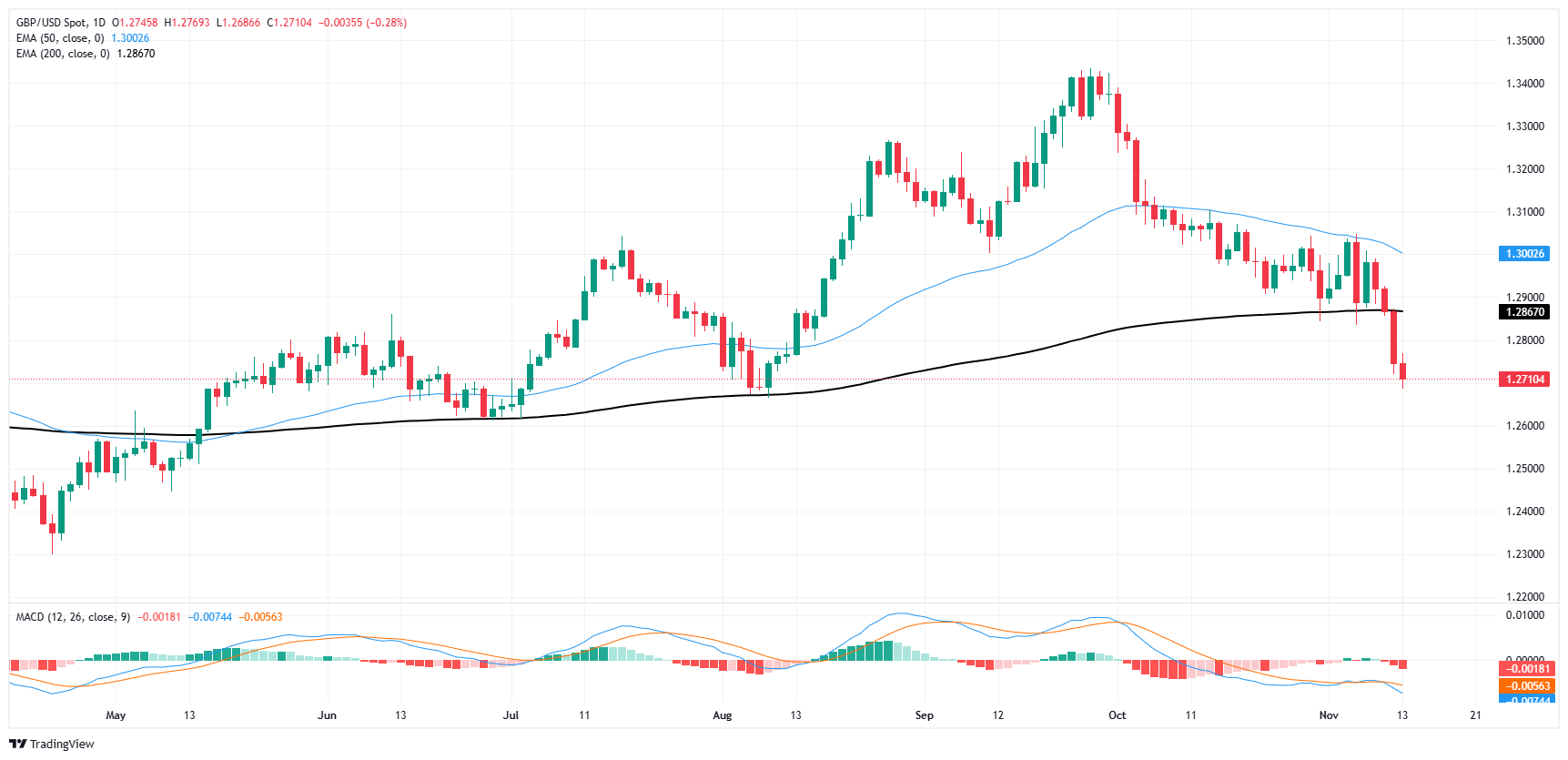- GBP/USD tested below the 1.2700 handle on Wednesday, easing back further.
- Cable shed another third of a percent and sold off for a fourth straight day.
- US PPI inflation, UK GRDP growth update loom ahead.
GBP/USD eased further into the low end on Wednesday, trimming further south of the 200-day Exponential Moving Average (EMA) in a one-sided bearish decline as the pair closes in the red for a fourth consecutive trading day. The Pound Sterling shed extra weight against the broadly-recovering Greenback, sparked by a US Consumer Price Index (CPI) inflation print that didn’t deliver markets the easing inflation hint they were hoping for, but still came in at forecasts.
Coming up on Thursday will be a fresh print of US Producer Price Index (PPI) business level inflation, which is forecast to accelerate in October to 3.0% from 2.8% YoY. On the UK side, Cable traders will be settling in for a wait to Thursday’s UK Gross Domestic Product (GDP) print for the third quarter, which is forecast to slump to a scant 0.2% QoQ from the previous 0.5%.
US Consumer Price Index (CPI) inflation figures came in stickier than many had hoped, but still well within median market forecasts, helping to keep investor sentiment elevated. Headline CPI held steady at 0.2% MoM as expected, while annualized headline CPI inflation accelerated to 2.6% YoY from the previous 2.4%, as markets predicted. Core CPI inflation also met market expectations, holding at 0.3% MoM and 3.3% on an annualized basis.
GBP/USD price forecast
The GBP/USD daily chart shows a pronounced bearish momentum, with the price decisively breaking below the 200-day EMA (black line) around 1.2867, a significant support level that had held since early November. This breakdown below the 200-day EMA indicates a shift toward a medium-term bearish outlook, as the currency pair struggles to hold above this key long-term moving average. Moreover, the 50-day EMA (blue line) remains below the price level, reinforcing the downward bias and suggesting that selling pressure is likely to persist as long as the price trades beneath these critical EMAs.
The MACD indicator at the bottom of the chart reflects intensifying bearish momentum, with the MACD line diverging further below the signal line in negative territory. This bearish crossover, accompanied by declining histogram bars, underscores the weakness in GBP/USD and hints at a potential extension of the downtrend. The lack of any bullish divergence on the MACD suggests that buying interest is limited, and without a substantial catalyst, the pair may struggle to regain positive momentum. Traders might look to the MACD and any potential decrease in selling pressure as initial signs of a trend reversal, though such signals are currently lacking.
The next support level to watch lies around the psychological handle of 1.2700, which is close to the current price level. A break below this area could expose GBP/USD to further downside risks, potentially targeting the 1.2600 mark as the next support level. On the flip side, if the pair manages to recover and reclaim the 200-day EMA, it could signal a shift in sentiment; however, this would require substantial buying pressure, likely tied to positive economic data from the UK or a broad weakening in the US dollar. Until such developments occur, the technical setup favors the bears, with further downside likely if GBP/USD fails to stabilize above the immediate support.
GBP/USD daily chart
Pound Sterling FAQs
The Pound Sterling (GBP) is the oldest currency in the world (886 AD) and the official currency of the United Kingdom. It is the fourth most traded unit for foreign exchange (FX) in the world, accounting for 12% of all transactions, averaging $630 billion a day, according to 2022 data. Its key trading pairs are GBP/USD, also known as ‘Cable’, which accounts for 11% of FX, GBP/JPY, or the ‘Dragon’ as it is known by traders (3%), and EUR/GBP (2%). The Pound Sterling is issued by the Bank of England (BoE).
The single most important factor influencing the value of the Pound Sterling is monetary policy decided by the Bank of England. The BoE bases its decisions on whether it has achieved its primary goal of “price stability” – a steady inflation rate of around 2%. Its primary tool for achieving this is the adjustment of interest rates. When inflation is too high, the BoE will try to rein it in by raising interest rates, making it more expensive for people and businesses to access credit. This is generally positive for GBP, as higher interest rates make the UK a more attractive place for global investors to park their money. When inflation falls too low it is a sign economic growth is slowing. In this scenario, the BoE will consider lowering interest rates to cheapen credit so businesses will borrow more to invest in growth-generating projects.
Data releases gauge the health of the economy and can impact the value of the Pound Sterling. Indicators such as GDP, Manufacturing and Services PMIs, and employment can all influence the direction of the GBP. A strong economy is good for Sterling. Not only does it attract more foreign investment but it may encourage the BoE to put up interest rates, which will directly strengthen GBP. Otherwise, if economic data is weak, the Pound Sterling is likely to fall.
Another significant data release for the Pound Sterling is the Trade Balance. This indicator measures the difference between what a country earns from its exports and what it spends on imports over a given period. If a country produces highly sought-after exports, its currency will benefit purely from the extra demand created from foreign buyers seeking to purchase these goods. Therefore, a positive net Trade Balance strengthens a currency and vice versa for a negative balance.
Information on these pages contains forward-looking statements that involve risks and uncertainties. Markets and instruments profiled on this page are for informational purposes only and should not in any way come across as a recommendation to buy or sell in these assets. You should do your own thorough research before making any investment decisions. FXStreet does not in any way guarantee that this information is free from mistakes, errors, or material misstatements. It also does not guarantee that this information is of a timely nature. Investing in Open Markets involves a great deal of risk, including the loss of all or a portion of your investment, as well as emotional distress. All risks, losses and costs associated with investing, including total loss of principal, are your responsibility. The views and opinions expressed in this article are those of the authors and do not necessarily reflect the official policy or position of FXStreet nor its advertisers. The author will not be held responsible for information that is found at the end of links posted on this page.
If not otherwise explicitly mentioned in the body of the article, at the time of writing, the author has no position in any stock mentioned in this article and no business relationship with any company mentioned. The author has not received compensation for writing this article, other than from FXStreet.
FXStreet and the author do not provide personalized recommendations. The author makes no representations as to the accuracy, completeness, or suitability of this information. FXStreet and the author will not be liable for any errors, omissions or any losses, injuries or damages arising from this information and its display or use. Errors and omissions excepted.
The author and FXStreet are not registered investment advisors and nothing in this article is intended to be investment advice.
Recommended content
Editors’ Picks

Gold price taps $3,300; fresh record high amid trade war concerns and weaker USD
Gold price continues scaling new record highs through the Asian session on Wednesday and has now moved well within striking distance of the $3,300 round-figure mark. Persistent worries about the escalating US-China trade war and US recession fears amid the ongoing US tariff chaos continue to boost demand for gold.

EUR/USD holds firm above 1.1350 amid renewed US Dollar weakness
EUR/USD is storngly bid above 1.1350 in European trading on Wednesday. The pair draws support from a fresh round of selling in the US Dollar amid persistent fears over US-China trade war and a lack of progress on EU-US trade talks. US consumer data and Powell speech are in focus.

GBP/USD trades at fresh 2025-high above 1.3250 after UK CPI data
GBP/USD builds on its six-day winning streak and trades at its highest level since October above 1.3250 in the European session on Wednesday. The data from the UK showed that the annual CPI inflation softened to 2.6% in March from 2.8% in February but had little impact on Pound Sterling.

Exchange inflows surge as XRP slides, what comes next?
Ripple corrected along with other major digital assets, including Bitcoin and Ethereum, and traded at $2.08 at the time of writing on Wednesday. The drawdown cut across the crypto market, causing the total capitalization to drop 3.2% to $2.736 trillion.

Is a recession looming?
Wall Street skyrockets after Trump announces tariff delay. But gains remain limited as Trade War with China continues. Recession odds have eased, but investors remain fearful. The worst may not be over, deeper market wounds still possible.

The Best brokers to trade EUR/USD
SPONSORED Discover the top brokers for trading EUR/USD in 2025. Our list features brokers with competitive spreads, fast execution, and powerful platforms. Whether you're a beginner or an expert, find the right partner to navigate the dynamic Forex market.



